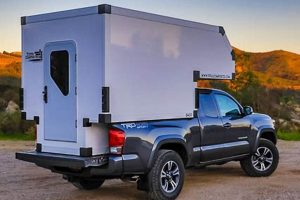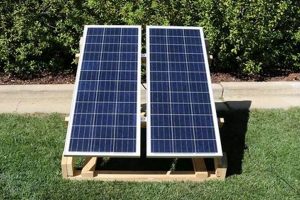Components designed to facilitate the independent assembly and installation of photovoltaic systems for residential use represent a growing segment of the renewable energy market. These packages typically include solar panels, inverters, mounting hardware, wiring, and instructions, allowing homeowners to generate electricity from sunlight and potentially reduce reliance on traditional power grids. The process inherently involves a degree of self-sufficiency and hands-on engagement.
The adoption of such systems offers several potential advantages, including decreased electricity costs, increased property value, and a reduced carbon footprint. Historically, these installations required specialized knowledge and professional assistance, but the emergence of readily available and comprehensive kits has broadened accessibility. The resulting increased individual involvement in energy production can contribute to a more sustainable future.
A detailed examination of the components included in these kits, the processes involved in their assembly and installation, and the factors to consider when evaluating their suitability for a particular residence will follow. Furthermore, exploration of safety precautions, regulatory considerations, and long-term maintenance requirements is warranted to provide a comprehensive understanding of residential solar power implementation.
Tips for Residential Photovoltaic System Implementation
The following guidance is offered to ensure a successful and safe experience when deploying independently assembled residential solar energy systems. Adherence to these points can optimize system performance and longevity.
Tip 1: Conduct a Thorough Site Assessment: Prior to procuring any equipment, evaluate the available roof space, its orientation, and any potential shading issues caused by trees or nearby structures. Sunlight exposure is a critical determinant of energy production.
Tip 2: Select a Reputable Kit Provider: Research different suppliers and prioritize those with established track records, comprehensive warranties, and readily available technical support. Verify certifications and compliance with industry standards.
Tip 3: Understand Local Regulations and Permitting Requirements: Familiarize with all applicable building codes, electrical codes, and grid interconnection agreements. Obtain necessary permits before commencing any installation work.
Tip 4: Prioritize Safety: Disconnect the main power supply before working on any electrical connections. Use appropriate personal protective equipment, including gloves and eye protection. If unfamiliar with electrical work, consult a qualified electrician.
Tip 5: Follow the Installation Instructions Meticulously: Adhere strictly to the manufacturer’s guidelines for mounting panels, wiring components, and commissioning the system. Do not deviate from recommended procedures.
Tip 6: Use Appropriate Tools and Equipment: Employ only tools specifically designed for electrical work and solar panel installation. Ensure all equipment is properly calibrated and in good working order.
Tip 7: Document the Installation Process: Keep detailed records of all wiring connections, panel placements, and system configurations. This documentation will be invaluable for troubleshooting and future maintenance.
Adhering to these recommendations will significantly increase the likelihood of a safe and productive installation of residential solar energy generation equipment, maximizing the return on investment and contributing to a sustainable energy future.
The subsequent sections will address specific considerations for maintaining the operational efficiency of the implemented system and maximizing long-term energy production.
1. Panel Efficiency
Panel efficiency, measured as the percentage of sunlight converted into electricity, constitutes a pivotal attribute of photovoltaic modules included in residential solar power systems. A higher efficiency rating translates directly to greater electricity generation per unit area of panel surface. This correlation is particularly significant for do-it-yourself installations, where homeowners often face spatial limitations on rooftops. In instances where available roof space is constrained, the selection of high-efficiency panels becomes crucial to maximize overall system output. For example, a panel with 20% efficiency will generate twice as much power as a similarly sized panel with 10% efficiency, given identical sunlight exposure.
Furthermore, the choice of panel efficiency affects the overall system design and cost. Lower efficiency panels necessitate a larger array to achieve a desired power output, resulting in increased costs for mounting hardware, wiring, and potentially a higher-capacity inverter. Conversely, investing in higher efficiency panels can reduce the number of panels required, leading to savings in balance-of-system costs and a more aesthetically pleasing installation. Several real-world examples, such as retrofit projects in urban environments with limited roof areas, demonstrate the necessity of employing high-efficiency panels to meet homeowner energy needs.
In summary, panel efficiency represents a fundamental consideration for individuals implementing solar power systems. The interplay between available space, energy requirements, and budgetary constraints dictates the optimal panel selection. A thorough understanding of panel efficiency ratings enables informed decision-making, leading to optimized system performance and cost-effectiveness. Challenges remain in balancing the higher upfront cost of premium panels with the long-term benefits of increased energy production and reduced system footprint, reinforcing the importance of careful planning and analysis before initiating a solar power implementation project.
2. Inverter Selection
Inverter selection is a critical determinant of the overall performance and reliability of residential photovoltaic systems. Within the context of component packages designed for self-assembly, the inverter serves as the central hub, converting direct current (DC) electricity generated by the solar panels into alternating current (AC) electricity suitable for household use and potential grid feed-in. An improperly sized or specified inverter can lead to energy losses, system instability, and even equipment damage, thereby negating the economic and environmental benefits of the solar installation. A system utilizing incorrectly specified inverters would not meet the expected energy output, regardless of panel quality.
The selection process requires careful consideration of several factors, including the total power output of the solar panel array, the local grid voltage and frequency, and any specific requirements imposed by the utility company for grid interconnection. Inverters are typically categoriz
ed as string inverters, microinverters, or power optimizers. String inverters are a cost-effective solution for installations where all panels receive uniform sunlight, but they are susceptible to performance degradation if even a single panel is shaded. Microinverters, mounted directly on individual panels, offer enhanced performance in partially shaded conditions and provide module-level monitoring. Power optimizers, used in conjunction with a central inverter, similarly mitigate shading effects and enable module-level data collection. For example, a homeowner with a roof partially shaded by trees would likely benefit more from microinverters or power optimizers than a string inverter, even if the string inverter is less expensive.
Ultimately, appropriate inverter selection hinges on a comprehensive understanding of site-specific conditions and system design parameters. A mismatched inverter diminishes system effectiveness, undermining the advantages inherent in a DIY approach. Rigorous evaluation of inverter specifications, adherence to local regulatory requirements, and potentially consultation with a qualified electrical professional are essential steps to ensure optimal performance and long-term reliability of residential solar energy systems. The inverter is not merely a component; it is the system’s brain.
3. Mounting Security
The structural integrity of residential solar power systems, particularly those assembled and installed independently, hinges critically on the security of the mounting hardware. Inadequate mounting can lead to panel displacement, system failure, and potential property damage, thereby undermining the investment in renewable energy.
- Wind Load Resistance
The primary function of solar panel mounting systems is to withstand significant wind loads. Improperly installed or inadequately rated mounting hardware can result in panels being dislodged during high winds, posing a hazard to surrounding properties and individuals. For example, coastal regions or areas prone to strong storms necessitate robust mounting solutions capable of withstanding extreme wind pressures. Compliance with local building codes regarding wind load requirements is paramount.
- Roof Attachment Integrity
The method of attachment to the roof structure directly impacts the long-term stability of the solar array. Penetrations through the roof surface must be properly sealed to prevent water intrusion, which can lead to structural damage and mold growth. The use of appropriate flashing and sealants is essential. Furthermore, the type of roofing material (e.g., asphalt shingles, tile, metal) dictates the appropriate attachment method. A universal mounting solution is not suitable for all roof types.
- Material Compatibility
The materials used in the mounting system must be compatible with both the solar panels and the roofing material. Dissimilar metals can cause galvanic corrosion, weakening the mounting structure over time. Stainless steel and aluminum are commonly used materials due to their corrosion resistance, but the specific alloy and grade should be carefully considered. Direct contact between dissimilar metals should be avoided through the use of insulating washers or spacers.
- System Longevity
Mounting hardware contributes significantly to the overall lifespan of the solar power system. A poorly designed or manufactured mounting system can degrade over time due to environmental factors such as UV exposure, temperature fluctuations, and humidity. Selecting mounting hardware with a proven track record of durability and resistance to these factors is crucial for ensuring the long-term performance and safety of the installation.
These facets of mounting security underscore the importance of selecting appropriate mounting hardware and adhering to best practices during installation. Component packages designed for independent residential installations must prioritize comprehensive instructions and readily available technical support to ensure homeowners can properly secure their solar arrays. Failure to address these considerations can compromise the structural integrity of the system and negate the anticipated benefits of renewable energy generation.
4. Wiring Standards
Adherence to established wiring standards is paramount in residential solar power installations, especially when leveraging component packages for independent assembly. These standards, codified in regulations such as the National Electrical Code (NEC) in the United States or equivalent codes in other regions, dictate the proper selection, installation, and protection of electrical conductors and components. Deviations from these standards can result in fire hazards, electric shock risks, and equipment malfunctions, thereby compromising the safety and efficacy of the entire system. For example, utilizing undersized wiring, failing to properly ground the system, or omitting essential overcurrent protection devices can lead to catastrophic failures, negating the benefits of renewable energy generation.
The implications of wiring standards extend beyond immediate safety concerns to encompass system longevity and performance. Correctly sized conductors minimize voltage drop, ensuring efficient power delivery and preventing overheating. Proper grounding techniques mitigate the risk of electrical surges and protect sensitive electronic equipment. Compliance with these standards also facilitates grid interconnection, enabling homeowners to sell excess electricity back to the utility company, thereby maximizing their return on investment. Consider the scenario where an improperly grounded system causes repeated tripping of circuit breakers, rendering the solar installation ineffective and requiring costly repairs. The value of strictly adhering to standards is clearly demonstrated.
In summary, wiring standards constitute an indispensable element of safe and effective residential solar power implementations, especially those undertaken independently. Understanding and diligently applying these standards mitigates risks, optimizes performance, and ensures the long-term reliability of the system. Challenges remain in ensuring widespread awareness and adherence among do-it-yourself installers, underscoring the importance of clear documentation, accessible training resources, and potentially the involvement of qualified electrical professionals to guarantee code compliance and system integrity. This is about both maximizing efficiency and ensuring safe energy operation for decades to come.
5. Grid Interconnection
Grid interconnection represents a critical juncture in the functionality of residential photovoltaic systems, enabling homeowners utilizing component packages for self-assembly to both draw electricity from the utility grid and export excess generated power back to it. This two-way flow necessitates strict adherence to technical specifications and regulatory protocols to ensure system safety, grid stability, and equitable energy accounting.
- Net Metering Policies
Net metering policies, established by local jurisdictions and utility companies, dictate how excess solar ener
gy fed back into the grid is credited to the homeowner’s account. These policies can vary significantly, ranging from full retail rate compensation to avoided-cost rates. For instance, a homeowner generating more electricity than consumed during a billing cycle may receive credit for the surplus energy at the full retail rate, effectively offsetting future electricity bills. Understanding the specific net metering policies in one’s region is crucial for assessing the economic viability of a residential solar power system. - Interconnection Agreements
Formal interconnection agreements with the local utility are mandatory before activating a grid-tied solar power system. These agreements outline the technical requirements for connecting to the grid, including inverter specifications, safety disconnect mechanisms, and liability considerations. A typical agreement might stipulate that the homeowner is responsible for any damage caused to the grid by their solar system. Compliance with these agreements is essential for ensuring the safety and stability of the electrical grid and avoiding potential legal ramifications.
- Safety Standards and Equipment
Grid interconnection necessitates the implementation of specific safety measures to prevent hazardous conditions. These measures include the installation of a visible disconnect switch that allows the utility company to isolate the solar system from the grid during maintenance or emergencies. Additionally, anti-islanding protection, embedded within the inverter, automatically shuts down the solar system in the event of a grid outage to prevent backfeeding electricity into a de-energized grid. These safety features are not optional; they are essential for protecting utility workers and preventing damage to electrical equipment.
- Permitting and Inspection Processes
Most jurisdictions require permits and inspections for grid-tied solar power systems. The permitting process ensures that the system design complies with local building and electrical codes. Inspections verify that the installation meets safety standards and that the system is properly configured for grid interconnection. A homeowner failing to obtain the necessary permits or pass inspection may be denied permission to connect to the grid or face penalties. This regulatory oversight is a vital safeguard for ensuring the safety and reliability of the interconnected electrical system.
In summation, grid interconnection forms a critical link in the functionality of residential solar power installations assembled independently, governing the exchange of electricity between the home and the utility grid. Adherence to regulatory requirements and safety standards is paramount for ensuring system safety, grid stability, and the equitable accounting of energy production and consumption. The complexities inherent in grid interconnection underscore the importance of thorough planning, diligent execution, and potentially the involvement of qualified professionals to navigate the regulatory landscape and ensure compliance.
6. Permitting Compliance
The intersection of permitting compliance and residential photovoltaic systems assembled independently represents a critical aspect of successful renewable energy integration. Adherence to local, regional, and sometimes national building and electrical codes is not merely a procedural formality; it is a foundational element influencing system safety, legality, and long-term operational integrity. Component packages designed for homeowner assembly must explicitly address permitting requirements, providing detailed guidance and documentation to facilitate the approval process. The absence of such support can lead to project delays, financial penalties, and potential system decommissioning. Failure to secure the necessary permits can result in retroactive inspections, costly rework to meet code, and even legal action from local authorities. For example, a homeowner who installs a system without proper permits may be forced to dismantle the entire installation if it does not meet current safety standards.
The complexity of permitting compliance stems from variations in regulations across different jurisdictions. Specific requirements may pertain to structural load calculations, wiring methods, grid interconnection protocols, and fire safety provisions. The onus rests on the homeowner to navigate these intricacies, often requiring consultation with local building officials or qualified electrical contractors. Reputable component package providers mitigate this challenge by offering pre-engineered designs that meet common code requirements and providing comprehensive documentation packages tailored to specific regions. These packages may include structural engineering reports, electrical schematics, and step-by-step installation guides that simplify the permitting process. This proactive approach significantly increases the likelihood of successful project approval and reduces the risk of code violations.
In conclusion, permitting compliance is an indispensable component of residential photovoltaic systems assembled independently. The interaction between stringent regulatory requirements and the do-it-yourself nature of these installations necessitates meticulous planning, thorough documentation, and a commitment to adhering to established codes. Component package providers who prioritize permitting support empower homeowners to navigate the complexities of the regulatory landscape, ensuring the safe, legal, and sustainable integration of solar energy into their homes. This focus on compliance not only protects homeowners from potential liabilities but also contributes to the broader adoption of renewable energy technologies by fostering public trust and confidence in the safety and reliability of these systems.
7. System Monitoring
The integration of system monitoring within residential photovoltaic installations, particularly those utilizing do-it-yourself component packages, is critical for ensuring optimal performance, detecting anomalies, and maximizing energy production. Real-time data acquisition and analysis provide homeowners with actionable insights into system behavior, enabling informed decision-making regarding maintenance and optimization.
- Performance Tracking and Analysis
System monitoring allows for the continuous tracking of key performance indicators, such as DC voltage, AC power output, and energy yield. By analyzing these metrics over time, homeowners can identify performance degradation, shading issues, or equipment malfunctions. For example, a sudden drop in power output on a sunny day may indicate a panel failure or inverter issue requiring immediate attention. Regular performance analysis facilitates proactive maintenance and prevents significant energy losses.
- Remote Access and Control
Modern system monitoring platforms offer remote access via web browsers or mobile applications, empowering homeowners to monitor system performance from anywhere with an internet connection. This remote access enables timely detection of problems and allows for remote control of certain system functions, such as inverter settings or load management. A homeowner on vacation could, for instance, remotely diagnose a system issue and contact a qualified technician for assistance, minimizing downtime and maximizing energy production.
- Alert
and Notification SystemsSophisticated monitoring systems incorporate alert and notification capabilities, automatically notifying homeowners of critical events such as inverter faults, over-voltage conditions, or grid outages. These alerts can be delivered via email, SMS, or push notifications, enabling prompt response to potential problems. An alert indicating an inverter over-temperature condition, for instance, would prompt the homeowner to investigate potential ventilation issues or contact a service technician, preventing permanent equipment damage.
- Data Logging and Reporting
Comprehensive system monitoring platforms log historical data, allowing for the generation of detailed performance reports. These reports can be used to track energy production over time, assess the impact of seasonal changes, and verify system warranty claims. A homeowner experiencing lower-than-expected energy production could use historical data to demonstrate a gradual decline in panel performance to the manufacturer, facilitating warranty claims and ensuring equitable compensation.
These facets of system monitoring collectively enhance the value proposition of do-it-yourself residential photovoltaic installations. By providing real-time insights into system behavior, monitoring platforms empower homeowners to optimize performance, detect anomalies, and maximize the economic and environmental benefits of their solar energy investment. The integration of advanced monitoring capabilities transforms a passive solar installation into an actively managed energy asset, promoting long-term sustainability and energy independence.
Frequently Asked Questions Regarding Residential Photovoltaic Component Packages
The following inquiries address common concerns and misconceptions surrounding the independent assembly and installation of solar energy systems for residential applications.
Question 1: Is Prior Electrical Experience Required for System Installation?
While no formal electrical certifications are mandated for the assembly of these systems, a fundamental understanding of electrical principles is strongly advised. The risks associated with improper wiring or connections include fire hazards and electrocution. Consultation with a licensed electrician is recommended, particularly for individuals lacking prior electrical experience.
Question 2: What is the Typical Payback Period for a Residential Solar Power System?
The payback period, representing the time required to recoup the initial investment, varies depending on factors such as system size, electricity consumption patterns, local energy costs, and available government incentives. Generally, payback periods range from 5 to 15 years. A detailed financial analysis, considering these variables, is essential prior to system procurement.
Question 3: How Does Shading Affect System Performance?
Shading significantly reduces solar energy generation. Even partial shading of a single panel can disproportionately impact the overall system output. Site assessments should thoroughly evaluate potential shading from trees, buildings, and other obstructions. Mitigation strategies include panel relocation, tree trimming, or the use of microinverters or power optimizers.
Question 4: What Maintenance is Required for Residential Solar Power Systems?
Routine maintenance typically involves periodic cleaning of the solar panels to remove dust, debris, and bird droppings. Inspections of wiring connections and mounting hardware are also recommended. Inverters may require periodic servicing or replacement, depending on their lifespan and operating conditions. A proactive maintenance schedule is crucial for maximizing system longevity and performance.
Question 5: Are Solar Panels Recyclable?
Yes, solar panels are recyclable, although the process can be complex and costly. End-of-life recycling involves recovering valuable materials such as silicon, aluminum, and glass. An increasing number of recycling facilities are emerging to address the growing volume of decommissioned solar panels. Responsible disposal and recycling practices are essential for minimizing the environmental impact of solar energy systems.
Question 6: How are Performance Warranties Typically Structured for These Systems?
Performance warranties, typically offered by panel manufacturers, guarantee a certain level of energy production over a specified period, often 25 years. These warranties typically stipulate a gradual decline in output, with a guaranteed minimum performance level at the end of the warranty period. Careful review of warranty terms and conditions is advised to understand coverage details and claim procedures.
These FAQs provide a foundational understanding of key considerations associated with residential solar component packages. Further research and consultation with qualified professionals are encouraged for informed decision-making.
The subsequent section will explore the long-term sustainability implications of widespread residential solar adoption.
Concluding Remarks
This exposition has explored the complexities and nuances inherent in leveraging solar power kits for homes diy. Key points emphasized include the necessity of meticulous site assessment, the criticality of adhering to wiring standards and permitting regulations, and the importance of selecting appropriate components, such as high-efficiency panels and correctly sized inverters. Proper mounting techniques and robust system monitoring capabilities were also underscored as essential elements for ensuring both the longevity and operational effectiveness of these systems. The economic and safety considerations associated with grid interconnection were also addressed in detail.
The viability of residential solar energy, especially when pursued through self-directed installations, relies heavily on informed decision-making and diligent execution. As technology advances and the cost of components decreases, the potential for widespread adoption remains significant. However, the responsibility for ensuring safety, code compliance, and optimal performance ultimately rests with the homeowner. A continued emphasis on education, accessible resources, and professional guidance is paramount to realizing the full potential of distributed solar energy generation and fostering a sustainable energy future.


![Easy DIY Gazebo Kit Assembly: [Your City/Style] The DIY Hub: Creative Crafts, Repairs & Life Hacks Easy DIY Gazebo Kit Assembly: [Your City/Style] | The DIY Hub: Creative Crafts, Repairs & Life Hacks](https://craftingdiycenter.com/wp-content/uploads/2025/07/th-4949-300x200.jpg)




